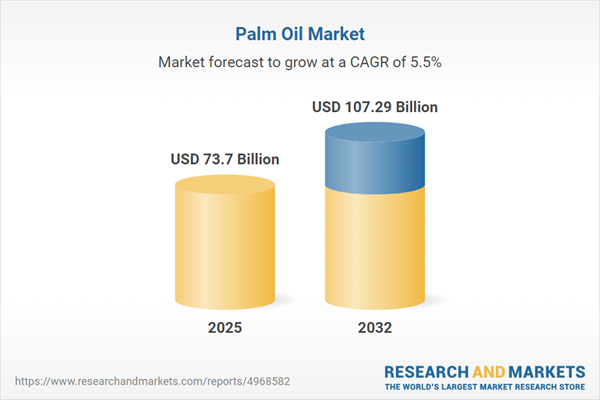Speak directly to the analyst to clarify any post sales queries you may have.
The palm oil market is adapting rapidly to global trends, with increasing complexity in sourcing, regulation, and sustainability requirements shaping decision-making for industry leaders.
Market Snapshot: Palm Oil Market Growth and Outlook
The palm oil market grew from USD 70.10 billion in 2024 to USD 73.70 billion in 2025, with projections indicating continued expansion at a CAGR of 5.46% to reach USD 107.29 billion by 2032. This momentum is fueled by strong demand across food, personal care, and biofuel industries while the sector navigates evolving regulatory and sustainability expectations worldwide.
Palm Oil Market Scope & Segmentation
This report delivers comprehensive coverage of the palm oil value chain, highlighting production, processing, applications, and trading environments across all major regions and industry segments.
- Types: Crude Palm Oil, Fractionated Palm Oil (Palm Olein, Palm Stearin), Palm Kernel Oil, Refined Palm Oil
- Sources: Conventional, Organic
- Product Grades: Cosmetic Grade, Edible Grade, Industrial Grade, Pharmaceutical Grade
- Extraction Methods: Cold-Pressed, Mechanical Pressing, Solvent Extraction
- Packaging Types: Bottled, Bulk, Flexible Pouches, IBC Tanks, Sachets
- Applications: Food, Animal Feed, Biofuel/Biodiesel, Detergents & Cleaning Agents, Personal Care & Cosmetics, Pharmaceuticals
- Distribution Channels: Offline (Convenience Store, Supermarket/Hypermarket), Online
- Regional Coverage: Americas (United States, Canada, Mexico, Brazil, Argentina, Chile, Colombia, Peru), Europe (UK, Germany, France, Russia, Italy, Spain, Netherlands, Sweden, Poland, Switzerland), Middle East (UAE, Saudi Arabia, Qatar, Turkey, Israel), Africa (South Africa, Nigeria, Egypt, Kenya), Asia-Pacific (China, India, Japan, Australia, South Korea, Indonesia, Thailand, Malaysia, Singapore, Taiwan)
- Leading Companies: Al-Khaleej Industries, Apical, Archer Daniels Midland, Boustead Holdings, Cargill, Genting Plantations, Godrej Agrovet, Golden Agri-Resources, IOI Corporation, Kuala Lumpur Kepong, Kulim (Malaysia), Mewah Group, Musim Mas, Oil Palm India, Olam Group, RGE, Sime Darby, Socfin Group, Srijaroen Group, United Palm Oil Industry, United Plantations, Univanich Palm Oil, Wilmar International
Key Takeaways for Senior Decision-Makers
- Stakeholders face simultaneous pressures from regulatory changes, rising sustainability expectations, and fluctuating raw material costs.
- Producers increasingly invest in traceability, certification, and digital platforms to manage compliance and enhance market transparency.
- Segment differentiation by application, source, and packaging is opening opportunities for tailored products in both food and non-food sectors.
- Advances in agronomic research and technology, including satellite monitoring and precision agriculture, are contributing to improved yields and reduced input costs.
- Circular economy solutions such as methane capture and biomass utilization support environmental targets and generate additional value streams.
- Mergers, acquisitions, and partnerships are strengthening vertical integration, helping companies secure resilience and optimize supply chain operations.
Tariff Impact: Navigating Policy-Driven Market Disruption
The recent implementation of new United States tariffs has realigned global trade patterns. Companies are adjusting strategies, seeking alternative markets, and investing in logistical infrastructure to maintain competitive positioning. Exporters are further developing value-added product streams, and downstream manufacturers are reevaluating formulations to mitigate rising costs and evolving sourcing constraints. Smallholder communities are adapting through aggregation and enhanced quality control to preserve access and maintain income stability.
Research Methodology & Data Sources
The analysis is grounded in both qualitative and quantitative research. Primary data was gathered via interviews and targeted surveys with industry stakeholders, while secondary research included extensive reviews of trade data, government policies, and sustainability standards. Triangulation and scenario analysis ensured validated findings and actionable insights.
Why This Report Matters
- Gain strategic clarity on palm oil market developments, key risks, and actionable opportunities relevant to executive planning.
- Access a robust segmentation framework with granular analysis of product, application, and regional trends, supporting investment and sourcing decisions.
- Understand the intersection of technology, regulation, and sustainability shaping supply chain resilience and long-term market competitiveness.
Conclusion
By integrating market intelligence, regulatory perspectives, and actionable recommendations, this report equips decision-makers to respond to evolving challenges and capitalize on new palm oil opportunities. Use these findings to inform executive strategy and optimize your position in a complex, fast-moving market.
Additional Product Information:
- Purchase of this report includes 1 year online access with quarterly updates.
- This report can be updated on request. Please contact our Customer Experience team using the Ask a Question widget on our website.
Table of Contents
3. Executive Summary
4. Market Overview
7. Cumulative Impact of Artificial Intelligence 2025
Companies Mentioned
The companies profiled in this Palm Oil market report include:- Al-Khaleej Industries Sdn Bhd.
- Apical Sdn Bhd
- Archer Daniels Midland Company
- Boustead Holdings Berhad
- Cargill, Incorporated
- Genting Plantations Berhad
- Godrej Agrovet Limited
- Golden Agri-Resources Ltd.
- IOI Corporation Berhad
- Kuala Lumpur Kepong Berhad
- Kulim (Malaysia) Berhad
- Mewah Group
- Musim Mas Group
- Oil Palm India Ltd.
- Olam Group Limited
- RGE Pte Ltd
- Sime Darby Berhad
- Socfin Group
- Srijaroen Group
- United Palm Oil Industry Public Company Limited
- United Plantations Berhad
- Univanich Palm Oil Public Co. Ltd.
- Wilmar International Limited
Table Information
| Report Attribute | Details |
|---|---|
| No. of Pages | 182 |
| Published | November 2025 |
| Forecast Period | 2025 - 2032 |
| Estimated Market Value ( USD | $ 73.7 Billion |
| Forecasted Market Value ( USD | $ 107.29 Billion |
| Compound Annual Growth Rate | 5.4% |
| Regions Covered | Global |
| No. of Companies Mentioned | 24 |









